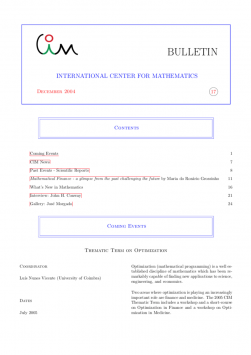Coming Events
1-7
- July 5-8: Workshop on Optimization in Finance
- July 11-15: Summer School on Geometric and Algebraic Approaches for Integer Programming
- July 20-22: Workshop on Optimization in Medicine
- July 26-29: Workshop on PDE Constrained Optimization
CIM news
7
CIM Events for 2006
The CIM Scientific Council will meet in Coimbra on February 12, to discuss the CIM scientific programme for 2006.
The CIM Thematic Term 2004 was about Mathematics and the Environment. The knowledge about the im- pact of human activities on our planet’s ecosystems is nowadays more vital than ever. Increasing human population to the detriment of others, cutting and burning vast areas of forest, polluting soil, air and water, are just a few examples of how we humans are altering our environment. Within this Thematic Term, some of these issues were addressed from a mathematical and physical modelling point of view.
Mathematical Finance - a glimpse from the past challenging the future
Maria do Rosário Grossinho
11-15
Mathematical Finance is a flourishing area of modern science that was born in 1900 with Louis Bachelier’s Ph.D thesis “Théorie de la speculation” [1]. This work is a result of his attempt to model stock prices on the Paris stock market. Since then, its importance has in- creased not only as the basis of the hectic financial activity of the modern world but also as a source of many interesting mathematical problems and theories.
Making wavelets in the art world. “Computers confront the art experts” is a piece by Philip Ball posted on November 22, 2004 at Nature’s online sitenews@nature.com. Ball’s subheadline reads: “Automated method seems to spot forgeries as well as a connoisseur does.”
John Horton Conway
Jorge Nuno Silva
21-23
Curia, 11th of September of 2004. Breakfast with John Horton Conway1
Professor Conway, can we start this interview with the genesis of On Numbers and Games (ONAG)2 and the Theory of Surreal Numbers?
José Morgado
António Machiavelo
Jorge Almeida
24-27
José Morgado was born in Pegarinhos, a small village near Favaios, in the Douro region, north of Portugal, on February 17, 1921.
